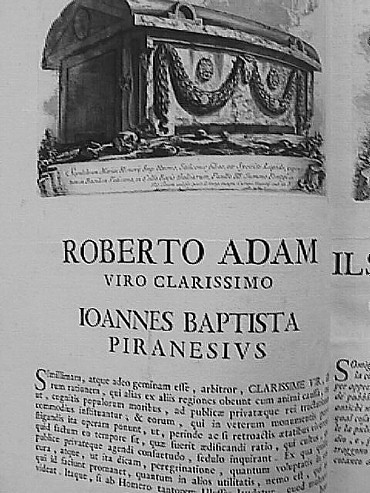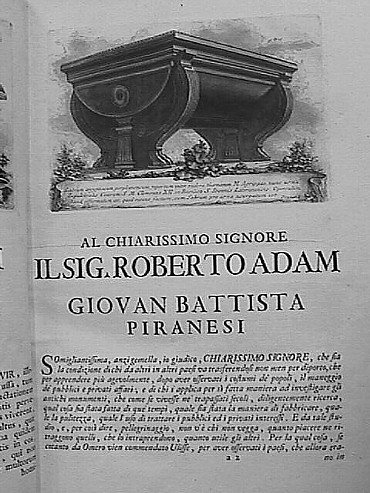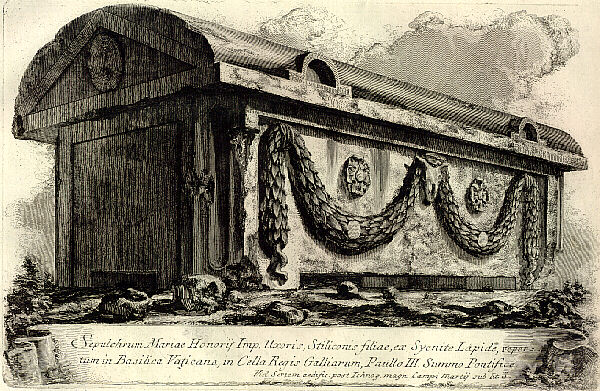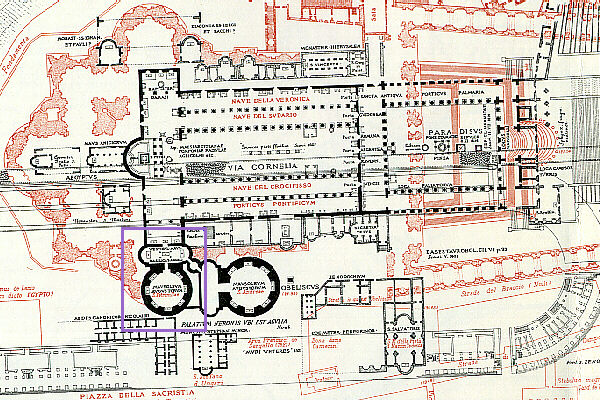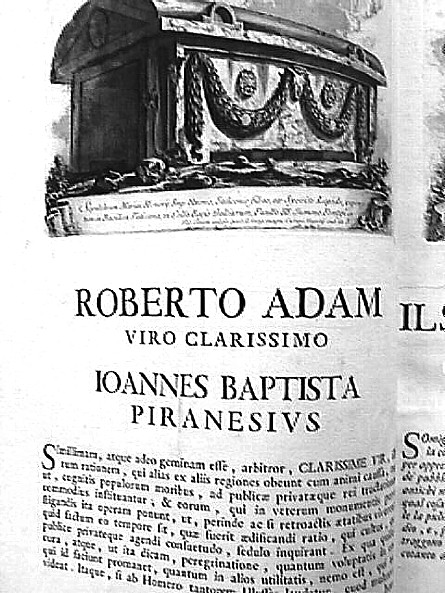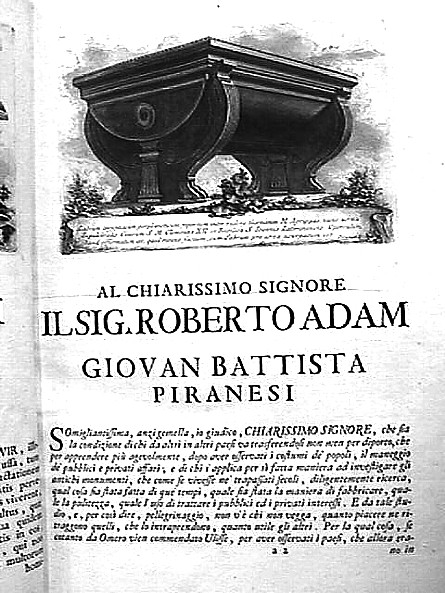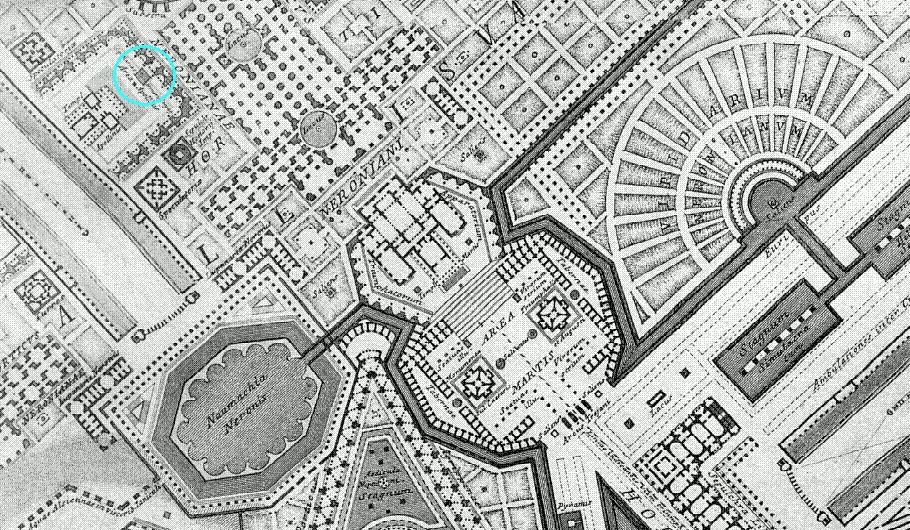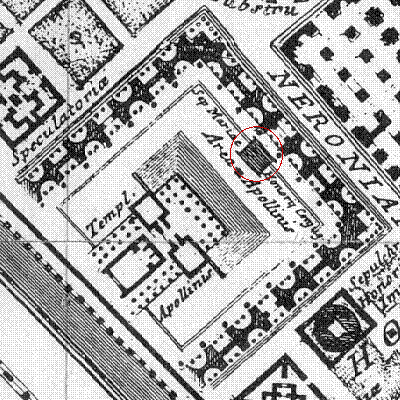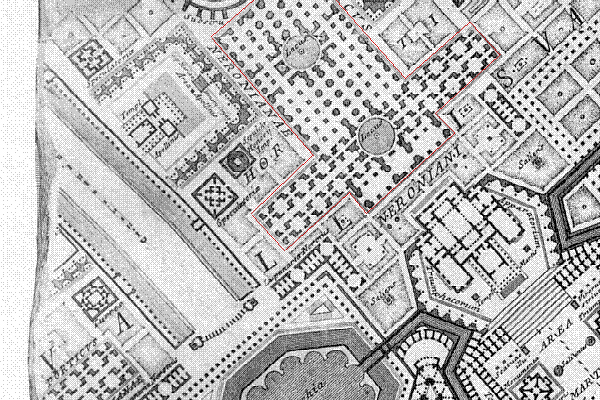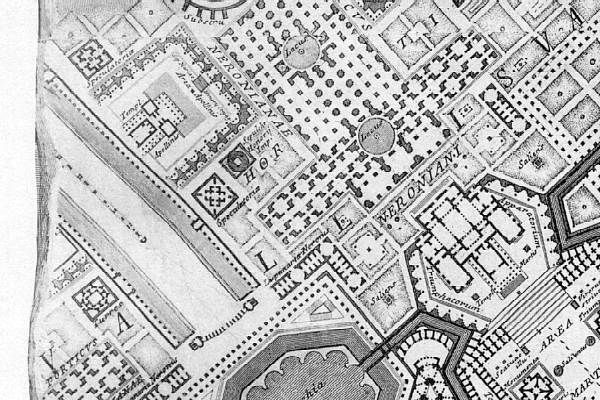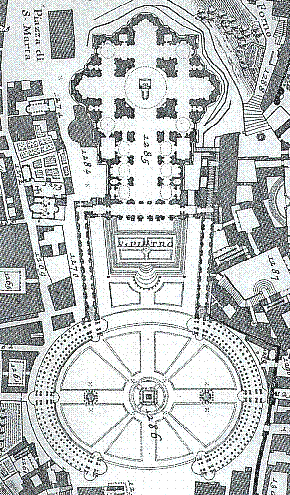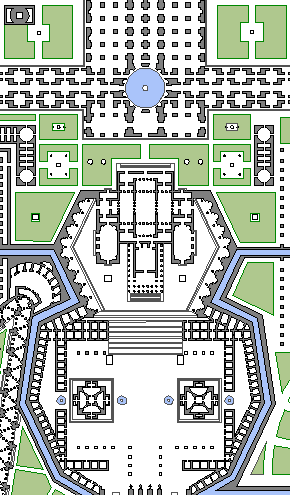sarcophagus of Maria
2001.03.06
The only sketches which have reached us represent a few perfume bottles found inside the grave. Of these flacons there are two sets of drawings, one in a codex of marchese Raffaelli di Cingoli, f.43, with the legend, "Five goblets of agate discovered in the foundations of S. Peter's during the pontificate of Paul III. in the tomb of Maria, daughter of Stilicho and wife of Honorius;" the other in the codex of Fulvio Orsino, No. 3439 of the Vatican Library.
The discovery took place in 1544. A greater treasure of gems, gold, and precious objects has never been found in a single tomb. The beautiful empress was lying in a coffin of red granite, clothed in a state robe woven of gold. Of the same material were the veil, and the shroud which covered the head and breast. The melting of these materials produced a considerable amount of pure gold, its weight being variously stated at thirty-five or forty pounds. Bullinger puts it at eighty, with manifest exaggeration. At the right of the body was placed a casket of solid silver, full of goblets and smelling-bottles, cut in rock crystal, agate, and other precious stones. There were thirty in all, among which were two cups, one round, one oval, decorated with figures in high relief, of exquisite taste, and a lamp, made of gold and crystal, in the shape of a corrugated sea-shell, the hole for the oil being protected and concealed by a golden fly, which moved around a socket. There were also four golden vases, one of which was studded with gems.
In a second casket of gilded silver, placed at the left side, were found one hundred and fifty objects, — gold rings with engraved stones, earrings, brooches, necklaces, buttons, hair-pins, etc. covered with emeralds, pearls, and sapphires; a golden nut, which opened in halves; a bulla which has been published in a special work by Mazzucchelli; and an emerald engraved with the bust of Honorius, valued at five hundred ducats. Silver objects were scarce; of these we find mentioned only a hairpin and a buckle of repoussé work.
The letters and names engraved on some pieces prove that they formed the mundus muliebris (wedding gifts) and toilet articles of Maria, Daughter of Stilicho and Serena, sister of Thermantia and Eucherius, and wife of the emperor Honorius. Besides the names of the four archangels — Raphael, Gabriel, Michael and Uriel — engraved on a band of gold, those of Domina Nostra Maria, and of Dominus Noster Honorius, were seen on other objects. The bulla was inscribed with the names of Honorius, Maria, Stilicho, Serena, Thermantia, and Eucherius, radiating in the form of a double cross with the exclamation "Vivatis!" between them. With the exception of this bulla, which was bought by Marchese Trivulzio of Milan, at the beginning of the present century, every article has disappeared. That the gold was melted, and that the precious stones were disposed of in various ways, so as to deprive them of their identity, is easy to understand, but where have the vases gone? Were it not for the rough sketches made at the time of the discovery we should not be able to form an idea of their beauty and elegance of shape. They were not the work of goldsmiths of the fifth century, but were of classical origin; in fact they represent a portion of the imperial state jewels, which Honorius had inherited from his predecessors, and which he had offered to Maria on her wedding day. Claudianus, the court poet, described them expressly as having sparkled on the breast and forehead of empresses in bygone days.
We know from Paul Diaconus that Honorius was laid to rest by the side his empress; his coffin, however, has never been found. It must still be concealed under the pavement of the modern church at the southern end of the transept, near the altar of the crucifixion of S. Peter.
Rodolfo Lanciani, Pagan and Christian Rome (New York: Houghton, Mifflin and Company, 1892), p. 203-205.
| |
Basilica of St. Peter's is absent...
2001.03.06
Re: lack of life
2002.01.19 11:46
...to learn more of Honorius (the younger son of Theodosius who is now Emperor of the West) and his wife Maria. Honorius was the last ancient ruler to [re]build the walls of Rome (because of the "Gothic Wars" -- Christian "Goths" that is) and he also built an imperial mausoleum attached to the original Basilica of St. Peter's. Sometime in the 1500s the sarcophagus of Maria was discovered (very likely while the old basilica was being demolished to make way for the new/present one). The sarcophagus of Maria may well be the last substantial imperial artifact of (the city of) Rome, and after an illustrious title page and a frontispiece, it is an image of the sarcophagus of Maria that Piranesi uses to begin his Campo Marzio publication. In a most elegantly covert way, Piranesi began the 'history' of the Campo Marzio with what is really it's ending, and what is probably the world's greatest designed architectural inversionary double theater goes on from there.
Maria, wife of the emperor Honorius...
2002.02.21
Maria, wife of the emperor Honorius, appears a second time within Piranesi's Il Campo Marzio in the "Ichnographia Campi Martii", the large fold-out plan where Piranesi reenacts ancient Rome's Campo Marzio and its environs, although in this instance, it is the sepulcher of Maria that is delineated rather than her sarcophagus.
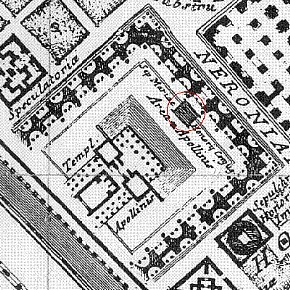
The sepulcher of Maria sits in front of the Templum Apollinis, and together these structures are within a court enclosed by rows of unnamed sepulchers and adjacent to the Circus of Caligula and Nero. This ensemble is part of the greater Garden of Nero, which is, and indeed was, situated within Rome's Vatican valley. It should be noted, however, that Piranesi separates the sepulcher of Maria from the sepulcher of the Emperor Honorius, the location where Maria's sarcophagus actually did lie. Moreover, neither the sepulcher of Maria nor that of Honorius are placed next to the Basilica of St. Peter's, which is altogether absent from the Ichnographia.
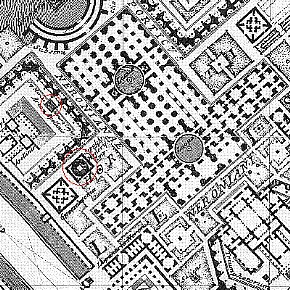
Essentially, Piranesi positions two of imperial Rome's Christian remains within an otherwise completely Pagan milieu, thus marking, albeit covertly, precisely where ancient Rome's inversion from Paganism to Christianity most resolutely occurred. Remember, St. Peter was martyred in the Circus of Caligula and Nero and the altar of St. Peter's Basilica marks St. Peter's tomb.
| |
It rocked Eisenman on his chair...
2007.11.09 10:56
Giovanni Battista Piranesi died today in 1778, on the feast of the dedication of the Basilica Constantiniani (known today as the Basilica of St. John Lateran), the first Christian basilica in Rome.
"Piranesi uses the Rome that was extent in the eighteenth century as a starting point, but that possesses no original value; it is merely a being in the present. From this existential moment of being, he takes buildings that existed in the first and second centuries, in Imperial Rome, and places them in the same framework of time and space as the eighteenth-century city."
--Peter Eisenman, "Notations of Affect. An Architecture of Memory" in Pathos, Affect, Gefühl (Berlin: Walter de Gruyter GmbH, 2004), pp.504-11.
If you actually study the Campo Marzio you'll find the starting point, framework and the millennium's worth of buildings that Piranesi utilized. First there are the altar and race course dedicated to Mars by Romulus in the mid-eighth century BC. Incidentally, this is how the Campo Marzio received its name--the fields of Mars. And to manifest the framework there is the last Imperial artifact of the Campo Marzio, the sepulcher of Empress Maria, wife of Honorius, from the early 5th century AD. Indeed the sarcophagus of Empress Maria holds a key position within the Il Campo Marzio publication. And to complete the framework, the last page of Il Campo Marzio depicts a double theater.
lost endings
2009.01.29 11:18
ultimately...
...like the fore and aft of Finnegan's Wake or the role of Sepulchrum Mariae Honorij Imp. Uxoris, Stiliconis filiae within Il Campo Marzio.
|
